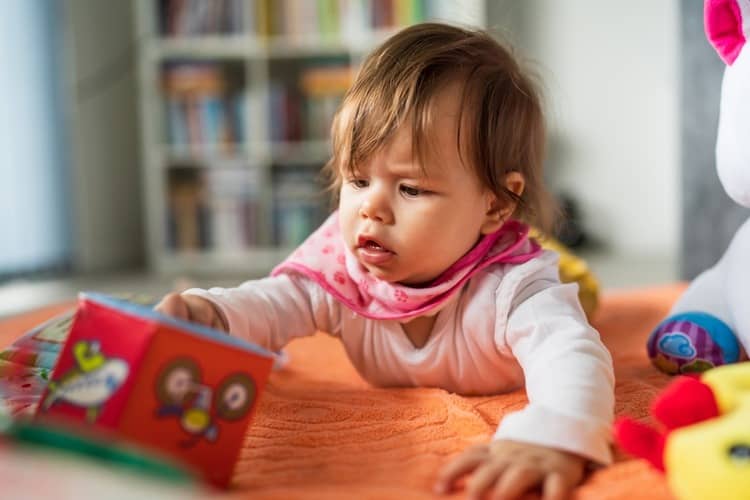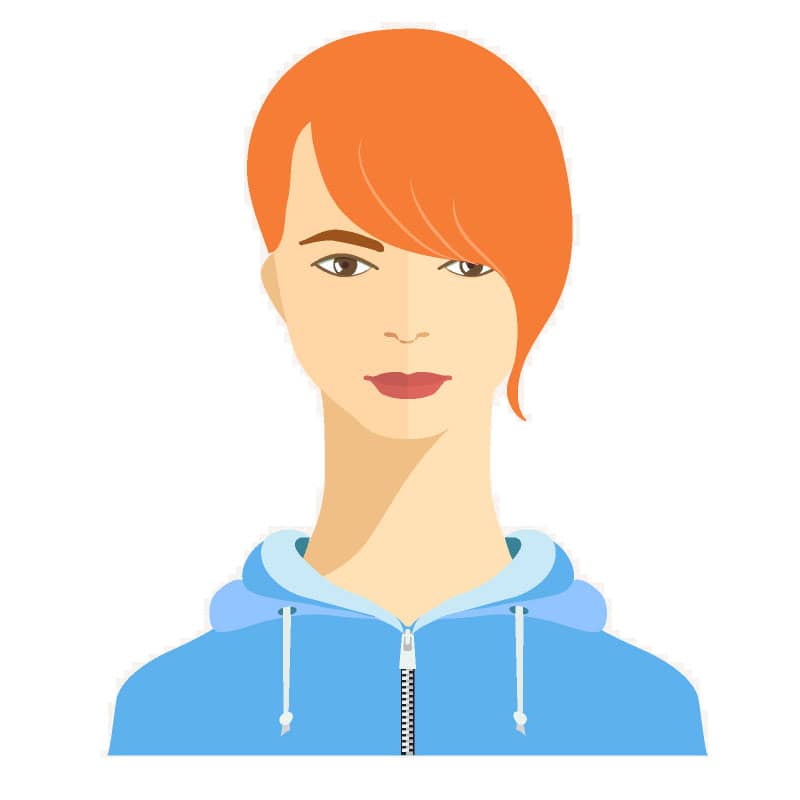
5-month-old baby (child) - development, diet, sleep, exercises, toys. See what it can do
If your child seemed to be too active a month ago, you can expect them to continue to be more active as they get to know their surroundings. The baby will move more, turn around, observe its surroundings, even new movements will appear, maybe even the first teeth, and you will finally know the final color of your baby's eyes. A 5-month-old baby will make faces, smiles and maybe try to pronounce the first syllables - ba, ma, ga and others. A baby turns into a child who actively seeks company and responds to all stimuli. A 20-week-old baby may not be able to sit up yet, but the more skilled ones can easily turn their head and turn from their back to their tummy.
What should a 5-month-old baby know or what should he be able to do and does he really need to be able to sit? Many milestones in the framework of growth and psychomotor development are only indicative for children in the first weeks. Each child has his own pace. However, with the gradual increase of weeks and months, possible deviations can be observed. A 5-month-old baby is making progress, but your little one can still wait for some points from the expected "table" progression. After all, the pediatrician can assess any deficiencies during a regular visit. This is also necessary in the 5th month due to re-vaccination. What is characteristic of the 5th month in a child?
What can a 5-month-old baby do?
Gross and fine motor skills also progress in these weeks. Eye and hand coordination is significantly improved, which greatly contributes to a better grip. You can stimulate touch by placing toys or pieces of clothing in your hands. The child has better observation skills, perceives the activities of people around him and tries to imitate some sounds or movements. A significant advance is the airplane, which is a position that the child can do in the tummy position. Both hands are folded, the legs are crossed or the baby is kicking with them, and the back is slightly bent. It is natural that children who can do this tend to roll over on their stomachs without help. The position on their stomach allows them to perceive the events around them much more intensively.
5-month-old babies may not yet be able to roll over from their tummy to their back, and sitting is not yet a topic either, although if you offer your fingers to the baby in the back position to help him pull himself up, he can sit up, hold his head and even hold it for a while balance. However, sitting is not yet mandatory in the 5th month and definitely do not let him stay in this position for a long time. Also, carrying in a vertical position is not yet relevant and it is better to choose a symmetrical position.
When lying on his stomach, the child regularly raises his chest and holds his head up, actively observing the surroundings. He may have a tendency to lean on one arm and reach for toys or other objects within close reach with the other. When lying on the back, the child can hold the body in a straight line. He actively touches his feet and hands, while his fingers "taste a lot" because he has them in his mouth very often. As well as other toys that he can grasp. By observing his hands and feet, he consciously controls and coordinates their movements. Lying on your stomach and kicking your feet in contact with the mat already indicate that crawling is not far away. They hold each other's hands even for a long time, which is again a positive sign in development.

A nervous 5-month-old baby and the first syllables
A child's vision continues to improve, and visual perception is a basic tool for cognition. If the child observes some regular activities that the parents do, he reacts to them by shouting, jumping or trying to utter the first syllables such as ma, ta, ba, brm, bu and repeat them. There is room for the parent to start imitating animal sounds to the child, which he can and often willingly begins to imitate. Although it will be more like mindless babbling. At the same time, the child recognizes sounds and their intensity. He notices when he hears voices in the distance. Grimaces and facial expressions of surprise or disgust are typical. The most beautiful reward for a parent is a baby's smile and spontaneous laughter. By the way, from the universal blue color of the eyes, the final one turns out already around the 5th month.
The child begins to grasp toys with both hands, begins to think in context. In addition to sounds, it can also imitate gestures and hand movements. He perceives that if he presses the toy and it makes a sound, he will press it on purpose. He perceives that if the mother repeatedly prepares the tub with water, bathing will follow. He does not understand the essence, but he perceives the connections. She continues to like to put everything in her mouth and there is also more abundant salivation.
And what can a 5-month-old baby be nervous about? It is not a rule, but the first baby teeth can appear in the 5th month of the baby. Cutting baby teeth can disrupt a child's sleep, cause fatigue, irritability, which manifests itself in crying, dissatisfaction and nervousness. Teething can be manifested by reddening of the gums or swelling. Not infrequently, an elevated temperature may appear.
Second dose of vaccine and preventive examination
In the 5th month, it is necessary to visit the pediatrician for the next, second dose of the hexavaccine (diphtheria, tetanus, pertussis, type B jaundice, cerebral palsy, hemophilus) and pneumococcal invasive diseases. The pediatrician will also check how the child is doing, how he is gaining weight, growing and what progress he is making. The mother reports progress in behavior to the pediatrician. Through observation, the doctor himself evaluates whether it is necessary to apply any physiotherapy exercises or supportive treatment.
The pediatrician also checks the baby's symmetrical position on his back and stomach and his psychomotor development. He observes whether the child in the 5th month can lift his chest and head on his stomach. Notice hand-eye coordination. Also, how the child rolls over on its side or even on its stomach, how it reaches for toys on the sides. In the event that the development falls short of expectations, he can recommend a visit to a neurologist, who can prescribe special rehabilitation exercises for a 5-month-old baby. If the child is already teething, inform the doctor about it, or ask him to check the condition of the teeth that are starting to appear.

5-month-old baby - food and snacks
Breast milk is the basis of the diet for breastfed children even at this age. For children fed with artificial milk, it is recommended to start with complementary foods in this period. The reason is the different nutritional value of artificial milk, which should be enriched as the months go by (from the 4th to the 5th month). Side dishes for a 5-month-old baby are mixed boiled vegetables or fruit puree. It can also be milk, rice or corn porridge.
It is not a mistake to supplement a breastfed child, although if the mother has enough milk, it is not yet necessary and it is recommended to start with complementary foods only after the baby is 6 months old. However, if you try the first foods and the child does not reject them, you can include non-dairy food in the menu. However, this definitely does not mean that you should limit breastfeeding or giving artificial milk. Non-dairy food is only a supplementary form of nutrition. If you are introducing complementary foods, start gradually to monitor possible allergic reactions.
Sleep and toys for a 5-month-old baby
A 5-month-old baby and his sleep have their own specifics, although in this area it is always about very individual aspects that define each baby's sleep. Some babies wake up 4 to 6 times a night, but this does not necessarily mean the need to feed. Sometimes cuddling or talking is enough and the baby continues to sleep. Others cry until they are fed or changed. Children's need for sleep is different, but the time they are awake is getting longer. Regularity is important, otherwise resistance to sleep can easily appear and problems with falling asleep or with the length of sleep may occur. Tiredness is manifested in the child by yawning, rubbing his eyes, passive approach to toys and surrounding phenomena. It can also be manifested by restlessness and blinking. It is better to put the child to sleep before these manifestations and to observe certain rituals that will signal the child's time to sleep.
Toys can greatly support a child's motor development. He will love to hold toys, reach for them, bang them or suck them. He still tests many objects by tasting them and putting them in his mouth. Take care of the hygiene of the toys to avoid infection in the oral cavity. Toys that make sounds, rattle or whistle are suitable. A very preferred choice are children's dolls, which return to their original position when touched with a swinging motion. Cushions or cotton playpens are also suitable to support movement, from which the baby can push off. Toys should be colorful and distinctive. Do not be afraid of longer walks in the stroller during the day. Of course, raise the child, play with him in the position on his back and on his stomach - grimaces, tickling or various touches are great stimulation.

The most frequent questions - FAQ
As a parent, do you see 5 months as a turning point in your child's life? Is your child already able to roll over from back to tummy? Are snacks already part of your baby's diet? Has he already pronounced the first syllables ma, ba, brm or bu? Share with us your experiences in raising and developing your baby? If you have interesting incidents, stories or advice or recommendations, we will be happy if you contribute to the discussion under the article with your comment.
What can a 5-month-old baby eat?
How to entertain a 5-month-old child?
When do babies' teeth start to grow?
Gallery
Pridať komentár














